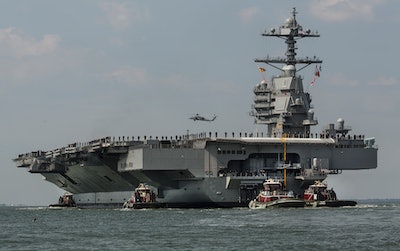
NORFOLK, Va. (AP) — Following years of delays and problems with its new technology, the U.S. Navy's most advanced aircraft carrier embarks on its first deployment next week and will train with other NATO countries at a time of increasing Russian aggression in Ukraine.
The USS Gerald R. Ford leaves the world's largest Navy base in Norfolk, Virginia, Monday along with destroyers and other warships, the U.S. Navy said in a statement Thursday. The carrier strike group will join ships in the Atlantic Ocean from countries that include France, Germany and Sweden for various exercises, including anti-submarine warfare.
"The Atlantic is an area of strategic interest," Vice Admiral Daniel Dwyer said in a statement. "Our primary goal is to contribute to a peaceful, stable and conflict-free Atlantic region through the combined naval power of our Allies and partners."
Dwyer commands the U.S. Navy's 2nd Fleet, which oversees American warships as they deploy between the U.S. East Coast and the Barents Sea, off of the coasts of Norway and Russia. The U.S. has sharpened its focus on the North Atlantic in recent years after the Russian military ramped up operations to a pace not seen since the end of the Cold War.
Next week's exercises come seven months after Russia invaded Ukraine. Western countries, including the U.S., have provide weapons to Ukraine, increasing tensions with the Kremlin. Last week, Russian President Vladimir Putin threatened to send more troops into battle and potentially use nuclear weapons to ward off Ukraine's attempt to reclaim control of Moscow-occupied areas.
Bradley Martin, a senior policy researcher with the RAND Corporation, told The Associated Press that next week's exercises will showcase American military capabilities and support for NATO. Concerns about Russia are part of the mission's broader calculus.
"We're also showing Russia that there are an array of forces they'd have to deal with if they go beyond Ukraine or escalate in Ukraine in ways we find unacceptable," said Martin, a retired Navy captain.
American aircraft carriers demonstrate the U.S.'s unique ability to dispatch warplanes around the world, Martin said. Despite the USS Ford's well-publicized problems, he said it's still part of a larger display of the nation's military might.
The $13.3 billion warship — the nation's most expensive — is the first of the Navy's new Ford class of aircraft carriers. They're designed to carry a wider variety of planes and operate with several hundred fewer sailors. They use an electromagnetic system for launching planes, which replace steam catapults and are supposed to increase flying missions by a third.
The Ford's first deployment comes five years after it was commissioned. And it's been beset by various issues, including problems with the launch system and the elevators that bring missiles and bombs to jets on the flight deck.
A Congressional Research Service report from late August stated that the Navy had "struggled to meet promises it repeatedly made" to defense oversight committees to complete, test and certify the weapons elevators. The Navy said the ship's 11th and final weapons elevator was certified in December.
In 2017, then-President Donald Trump told Time magazine that the Navy should revert to steam for launching planes because the electromagnetic system "costs hundreds of millions of dollars more money and it's no good."
Dwyer, the admiral, told reporters in a phone call on Monday that the Ford "has already successfully conducted over 10,000 catapults and carrier landings."
Martin, of the RAND Corporation, said the system is yet to launch planes at the higher rate for which it was designed. And it will likely take years to do so, which he said is not unexpected for the first in a new class of carriers.
"Aircraft carrier strike groups are still a center of Navy power projection," Martin said. "The fact that the lead ship in a new class has had some significant development issues doesn't change that."






















